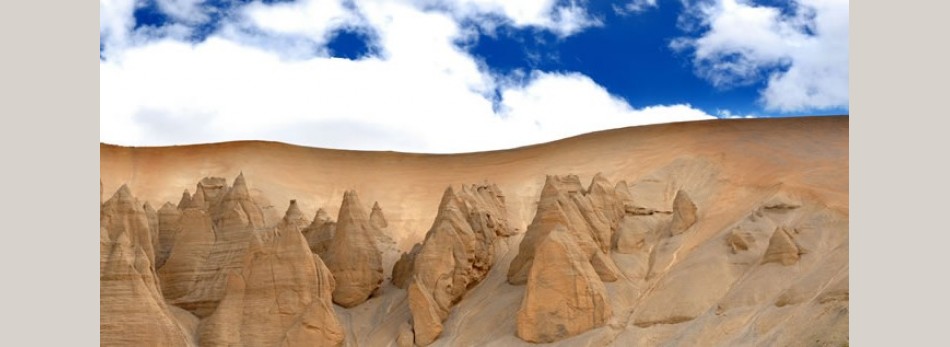Kashmiri

Kashmiri, also known as Keshur or Koshur, belongs to the Northwestern group of the Indo-Aryan branch of the Indo-European language family. It is the largest of the Dardic languages, and the only language in the Dardic group that boasts an early literary tradition. It is spoken primarily in the Jammu and Kashmir state of India. According to the 2001 census, it has 5.4 million speakers in India, with a total total of about 5.6 million speakers worldwide (Ethnologue).
Status
Kashmiri is one of the 22 official languages of India. Even though Urdu is the official language of the multilingual and multi-ethnic state of Jammu and Kashmir, Kashmiri is the majority language used as a medium of instruction in primary and middle schools. It serves as the medium of much of mass communication, such as newspapers, radio programs, and films. Most speakers of Kashmiri are fluent in a second language, typically Hindi/Urdu. Many Kashmiris also speak English.
Dialects
Although there has been no definitive research on the dialects of Kashmiri, they are usually divided into two groups based on the extent to which the language is affected by geography and by religious and social differences between Hindus and Muslims, as well as between the cities and the countryside.
Geographical dialects There are four major regional dialects which are listed below.
- Kashtawari (Kistwardi) spoken in the capital of Srinagar serves as basis for Standard Kashmiri.
- Rambani and Siraji are closely related to each other, but do not share a number of features with standard Kashmiri.
- Poguli is mutually intelligible with Standard Kashmiri.
Social dialects Social, or user-defined dialects, depend on the extent to which they were affected by either Sanskrit Perso-Arabic influence.
- Hindu Kashmiri which is heavily Sanskritized
- Muslim Kashmiri which is Persianized.
Structure
Due to its separation from other Indo-Aryan languages and its geographical proximity to the Perso-Arabic world, Kashmiri has developed some features that distinguish it from other Indian languages. These features involve both the sound system as well as the morphological and syntactic structure of the language.
In general, the sound system of Kashmiri shares many features with the sound systems of other Indo-Aryan languages, all of which have large inventories of vowels and consonants. Kashmiri syllables typically consist of a vowel preceded and followed by one or two optional consonants.
Vowels
Kashmiri has a a large inventory of vowels which can be short or long. Some long vowels (/i:/, /e:/, /ə:/, /u:/, /o:/) and some short vowels (/e/, /o/, /ə/, /a/) can also be nasalized. Vowel length and nasalization distinguish word meaning. In romanization, long vowels are usually marked by a colon (a:), while nasalized vowels are marked by a tilde (ã).
|
Front
|
Central
|
Back
|
|
|---|---|---|---|
| Close |
i, i:
|
ɨ, ɨ: |
u, u:
|
| Mid |
e, e:
|
ə, ə:
|
o, o: |
| Open | ɔ |
- /i/ = ea in peat
- /ɨ/ has no equivalent in English
- /e/ = e in pet
- /ə/ = a in ago
- /a/ = a in bar
- /u/ = oo in too
- /o/ = o in token
- /ɔ/ = o in bog (occurs only in a few words)
Consonants Unlike other Indian languages, Kashmiri does not have aspirated voiced stops.
| Labial | Dental | Retroflex | Palatal | Velar | Glottal | ||
| Stops | voiceless | p, pʰ | t, tʰ | ʈ, ʈʰ | k, kʰ | ||
| voiced | b | d | ɖ | g | |||
| Fricatives | voiceless | s | ʃ | ||||
| voiced | z | h | |||||
| Affricate | voiceless | ts, tsʰ | tʃ, tʃʰ | ||||
| voiced | dʒ | ||||||
| Nasal | m | n, | |||||
| Lateral | l | ||||||
| Rhotic | r | ||||||
| Semi-vowel | w | j |
- There is a contrast between aspirated vs. unaspirated stops and affricates, e.g., /p—pʰ, t—tʰ, k—kʰ, ts—tsʰ, tʃ—tʃʰ. Aspirated consonants are produced with a strong puff of air.
- There is a contrast between and apical vs. retroflex consonants, e.g., /t/ – /ʈ/, /d/ – /ɖ/. Apical consonants are produced with the tip of the tongue touching the roof of the mouth, whereas retroflex consonants are produced with the tongue curled, so that its underside comes in contact with the roof of the mouth.
- /ʃ/ = sh in shop
- /tʃ/ = ch in chop
- /dʒ/ = j in job
- /w/ can be realized as /w/ or /ʋ/
- /j/ = y in yet
Stress
Stress alone does not distinguish the meaning of words in Kashmiri. It typically falls on the heaviest syllable of the word. Syllables that contain Consonant + Vowel (CV) are heavier than syllables consisting of a single vowel (V), and Consonant + Vowel + Vowel (CVV) syllables are heavier than Consonant + Vowel (CV) syllables.
Grammar
Kashmiri is a highly inflected language that uses suffixes and postpositions to mark grammatical relations. It is an ergative language which means that the subjects of transitive verbs appear in the nominative case, while subjects of intransitive verbs appear in the ergative case.
Nouns
Kashmiri nouns are marked for the following grammatical categories:
- There are two genders: masculine and feminine.
- There are two numbers: singular and plural.
- There is an extensive system of cases. In the masculine singular, the nominative, dative, ergative, ablative and vocative cases are marked by suffixes, while the locative, instrumental, genitive, comitative, and allative cases are marked by postpositions.
Adjectives
- Adjectives belong to two categories: declinable, and indeclinable.
- Declinable adjectives are declined like nouns.
Pronouns
- Pronouns are declined like nouns.
- Third person personal pronouns and demonstratives have a three-way distinction between proximal ‘this’, remote ‘that’, and distal ‘yonder’.
Verbs
Kashmiri verbs agree with their subjects in person and number and with their objects in gender and number. Grammatical functions of verbs are expressed by suffixes. Verbs are inflected for the following categories:
- person: 1st, 2nd, 2nd honorific, 3rd
- gender: masculine, feminine
- number: singular and plural
- tense: present, past, future
- aspect: imperfective, and perfective
- mood: indicative, imperative, optative
Word order
The normal word order in Kashmiri sentences is Subject-Verb-Object. However, other word orders are possible to mark emphasis.
Vocabulary
Kashmiri has more words from Vedic Sanskrit than other Indian languages. Hindu Kashmiri has borrowed many words from Sanskrit than other Indian languages. Muslim Kashmiri, on the other hand, has many borrowings from Persian and Arabic. Below are a few words and basic phrases in Kashmiri.
| Hello | Assalām ‘alaikum (talking to a Muslim); Namaskār (talking to a Hindu);informal halo |
| Khuda hāfiz (talking to a Muslim); Namaskār (talking to a Hindu) | |
| Thank you | Meherbaeni |
| Yes | Ên |
| No | Na |
Numerals 1-10 in Kashmiri.
| 1 | 2 | 3 |
4 |
5 | 6 | 7 | 8 | 9 | 10 |
| Akh | Zė | Trê |
Çor |
Pāņçh | Shê | Sath | Äţh | Nav | Dāh |
Writing
Kashmiri uses its own writing system. The traditional script of Kashmiri is the Indian Sharada, a script that was developed around the 10th century AD. It is currently being used for very restricted purposes by select classes of Kashmiri society. The main writing system of Kashmiri today is a modified Perso-Arabic alphabet which is widely used for official and mass communication purposes. The language is known for its rich literary tradition, particularly, for its poetry, dating back to the 12 century AD. Kashmiri language and literature experienced two major influences. The earliest was that of Vedic Sanskrit. The later influences came from Persian and Arabic which began after the Muslim invasions and large-scale conversion to Islam.The language is known for its rich literary tradition, particularly for its poetry, dating from the 12th century A.D.
- Sharada (Sharda, Sarda) This script which was developed around the 10th century AD. It is the oldest script Kashmiri script. Today, it is used by a small group for religious purposes. Sharada symbols are different from the Devanagari script.
- Devanagari This script was used by Kashmiri Hindus for writing Kashmiri literature until 1947, and is still in use today.
- Perso-Arabic It is recognized as the official script for writing Kashmiri and is used by both Hindus and Muslims.







